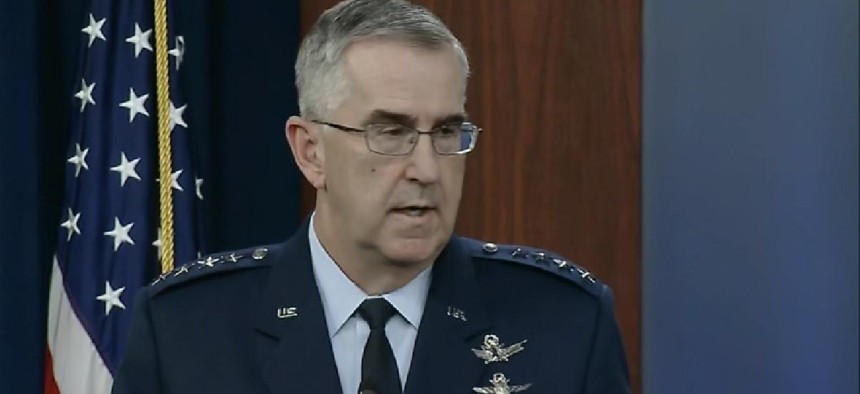
Hyten: Combat cloud would bolster collaboration with allies, partners
Gen. John Hyten, vice chairman of the Joint Chiefs of Staff, said building a combat cloud with correctly tagged data would allow service members, allies and partners alike to login from anywhere with their credentials and biometrics so the U.S. can take full advantage of the capabilities they have to offer.
Gen. John Hyten, vice chairman of the Joint Chiefs of Staff, indicated that the lack of an enterprise cloud is impeding the U.S. from collaborating with its closest allies.
"Even our closest allies, they can't get onto our basic secret system, SIPRNET," Hyten said, during the launch event of the National Defense Industry Association's Emerging Technologies Institute on July 26.
"Friends are our biggest advantage but not being able to take full advantage...is just wrong."
Hyten said building a combat cloud with correctly tagged data would allow service members, allies, and partners alike to login from anywhere with their credentials and biometrics so the U.S. can take full advantage of the capabilities they have to offer.
The Defense Department doesn't have that cloud capability yet – it recently canceled and re-scoped its troubled $10 billion Joint Enterprise Defense Initiative program -- it's also struggling to prepare for such a connected fight and modeling scenarios with capabilities from allies and partners.
"We have a pretty good capability to model air, land, and sea. But we can't model air, land, sea, space, and cyber. We can't model air, land, sea, space, cyber, and the electromagnetic spectrum that covers all those domains. We can't pull those in, so when we actually fight or look at a whole campaign, you have to make so many assumptions about what is happening in the other domains," the general said.
DOD has not made its war gaming more realistic, but the Joint Requirements Oversight Council (JROC) recently published a requirements document for integrated modeling and simulation capabilities in all domains as part of four Strategic Directives that instruct the services on what to do when developing new capabilities around contested logistics, joint fires, information advantage, and Joint All Domain Command and Control (JADC2).
"The goal is to be fully connected to a combat cloud that has all the information that you can access at any time and any place. You can pull it all together with all domain command and control, figure out the best data and be able to act quickly on that," he said, when describing the directives.
"Aggregating to fire, disaggregating to survive. That's the way it's going to be in data, that's the way it's going to be across the board," Hyten said.
As a result, the JROC is working with the Cost, Assessment, and Program Evaluation (CAPE) office, he said to "look at the entire force and make sure we understand how things play together, and to be able to turn it quickly and do hundreds and hundreds maybe even millions of runs in the time it takes us to do one war game with 200 people."
This article first appeared on FCW, a partner publication with Defense Systems. Photo: Gen. Hyten briefs reporters on April 22, 2020.
NEXT STORY: DOD rolls out AR/VR technology at 5G testbed
